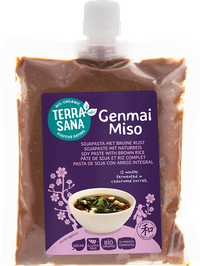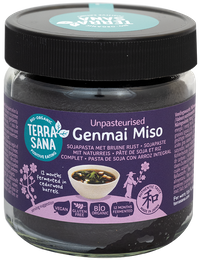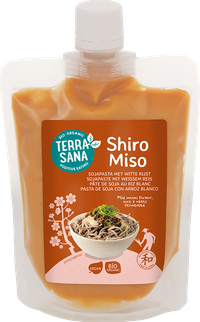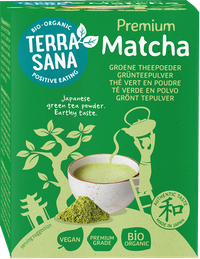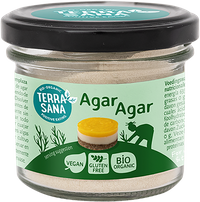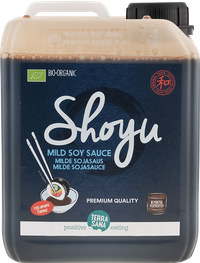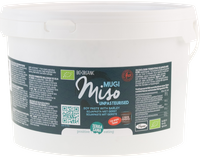What is miso and how to use it? + recipe ideas
What is miso? A guide through all miso types
Miso is a fermented soy paste from Japan. It looks like a thick spread. Miso consists of soybeans, sometimes supplemented with fermented brown rice, white rice or barley. By mixing these basic ingredients with koji (a good fungus), a fermentation process is set in motion. This fermentation process is super important, as it creates that delicious miso flavour. Fermentation sometimes takes weeks, months, and sometimes even years. The longer the fermentation, the more powerful the flavour.

How to use miso?
To use miso, add a little paste to your hot soup (broth), sauce, marinade or dressing. You can also use miso as a seasoning when roasting vegetables or in stews. In Japan, of course, miso is mainly used as a base for miso soup. If you really want to use miso the way the Japanese do, you only stir the miso into the soup when the heat is off. This ensures the best flavour and keeps the enzymes in the miso active as much as possible.
Miso is almost ‘addictive’. Once you have realized what you can do with it, you will soon be putting miso through everything. It adds flavour and is a great replacement for the often chemical stock cube. Miso is vegan, just like our other Japanese products. If you prefer not to use flavour enhancers or salt, miso is a tasty and pure alternative. No more chemical stock cube in your soup, just a scoop of miso.
Experiment with different types of miso, such as shiro miso or barley miso, to discover the flavour that best suits your dish. In the table below, you can immediately see how we would use miso.
Is miso vegan?
Yes, miso is suitable for vegans. Most types of miso are gluten-free as well as vegan, with the exception of miso paste with barley.
The differences at a glance
| Fermentation | Base | Taste | Structure | Use | |
| Hatcho miso | Min. 24 months | Soybeans | Very powerful | Solid | Stew & wok
Soup |
| Genmai miso | Min. 18 months | Soybeans and brown rice | Moderately powerful | Smooth | Soup
Marinate |
| Mugi miso | Min. 18 months | Soybeans and barley | Powerful | Smooth | Soup
Marinate |
| Shiro miso | 2-6 wks | Rice and soybeans | Mild | Slightly sturdy | Soup
Baking |
Mugi and genmai miso are the most similar in taste. Mugi miso has a slightly saltier taste and perhaps a bit more malty. You will automatically discover which one you prefer.
How long does miso fermentation take ?
Our miso has been traditionally made in Japan for generations. Speeding up the production or fermentation process does not affect the Japanese. In fact, that’s really out of the question. Miso needs time to mature and develop that super refined taste. Because that taste is really special! If you are familiar with Japanese cuisine, you will recognize the umami flavor in it. And did you know that umami is Japanese for “delicious”?
Shiro miso ferments only briefly, just long enough to convert the rice into sugars and still create that delicious salty miso flavour. So shiro is a relatively sweet miso, and therefore very suitable for use in sweet dishes. Mugi and genmai miso ferment for 12-18 months and are much darker in colour and more powerful in flavour. They ferment in 100-year-old vats, and this really makes a difference in terms of flavour. Hatcho miso is our most potent miso and ferments for 2 years.
Is miso pasteurized?
Hatcho miso ferments for at least 2 years. This is so extremely long that pasteurization is not necessary. That actually also applies to genmai and mugi miso in glass jar. They ferment for about 18 months.
Is the miso in bags? Then we do pasteurize the soy paste. If we don’t, it “grows” the miso out of the package and the package bulges. Pure necessity!
Miso for beginners – recipe ideas
Tasty recipes with miso
So how to use miso in recipes? If you’re going for a Japanese twist tonight, then miso is a versatile seasoning for lots of delicious Japanese recipes. Here are our best ideas for miso recipes.
- Miso soup or miso ramen are, of course, the number one choice. Briefly fry garlic, ginger, chilli, vegetables and seaweed of your choice in a pan and add water. Add the miso after you have the broth all ready and the heat is off. This will preserve the strength of the miso as much as possible! Season with an extra dash of tamari and eat with ramen noodles.
- Bread spread: mix 3 tablespoons of peanut butter or almond paste with 1-2 tsp of hatcho miso.
- Flavouring in (vegetarian) stews and wok dishes: combine with sesame oil and genmai su.
- Miso sauce: mix genmai miso paste with almond paste and sesame oil, possibly a little lemon juice.
- Marinade for vegetable, fish or meat (substitutes): smear aubergine or corn cob with miso, or marinate (vegan) chicken or tofu with miso, sesame oil, genmai su, chilli and garlic.
- Sweet dishes: shiro miso is also delicious in homemade ice cream or in ‘icing’ for cakes.
- Granola: marinate oat flakes and nuts with a mix of shiro miso paste, coconut oil, tahini and maple syrup.
How to make a quick and easy miso soup:
Choose the right miso for your miso dish
Going to make a miso recipe and don’t know which miso to choose?
Then for sweet dishes, think mainly of shiro miso, as it is sweeter and milder in flavour. If you go for a savoury miso dish, consider mugi, genmai or hatcho miso paste.
Hatcho miso is the most potent seasoning and most popular in Japan for miso soup and as a marinade for meat, fish and tofu. But hatcho also does super well in stews and wok dishes.
Genmai and mugi are a little more for everyday use, such as your daily miso soup, sauce or dip. Mixing a pinch of genmai with vegan mayo, for example, is a top idea!
How do I store miso?
It is best to store miso in the fridge, tightly sealed in its original packaging or in an airtight container. This keeps the miso fresh for longer and retains its flavour.
Where can I buy miso?
Depending on where you are in the world, you can buy miso in many organic supermarkets, health food stores and specialty shops. Prefer to shop online? Then Google miso+TerraSana and you’ll find a place to buy miso.










